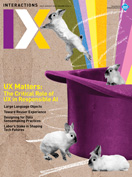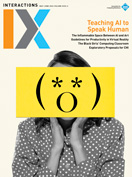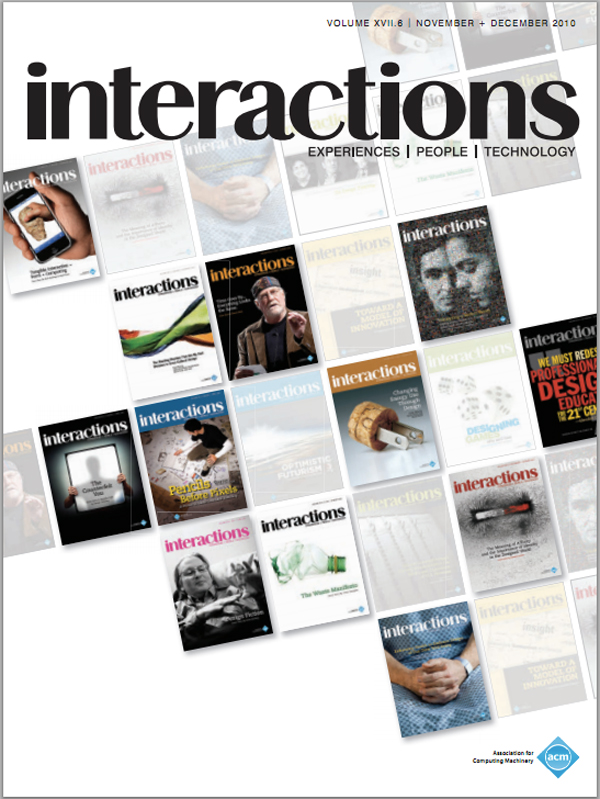Table of Contents
VOLUME XVII.6 November + December 2010
-
Welcome
-
WELCOMEInteractions
Richard Anderson, Jon Kolko
Richard and I took over the editorship of interactions magazine three years ago. In that short time, we've published 18 issues of content with the intent of satisfying both explicit and implicit goals, which were described in our first issue: To increase the relevance of this magazine to practitioners…
-
-
Ethereal
-
Designing for solitude
Ben Fullerton
Our lives demand more and more of our attention. In a relatively tiny span of time, our culture has begun to value states of connectedness, sharing, and constant availability, in a way that even our parents' generation could not have foreseen. And we seem to have become comfortable with…
-
Oh, beleaguered beauty
José Martínez Salmerón
Would you agree that one of the purposes of art is to enable us to relate to the world from a position of coherence? This relating to and making sense of all that surrounds us is enhanced when art either reflects abstracted atemporal notions on the one end, or…
-
REALizing our messy futures
Woodrow Winchester
I must admit, mission accomplished, Genevieve Bell. Bell's CHI 2010 plenary most definitely delivered on its explicit intent to provoke. As an HCI researcher and practitioner, I was moved to finally get "REAL" in order to deal with the messiness that the future has to offer. Coupled with a…
-
BETWEEN THE LINESThe taxonomy of the invisible
Liz Danzico
A spring 2010 app competition, NYC BigApps, brought together designers and developers to show how the city of New York could improve the way it provides information to its citizens. One of the 11 winning apps, "Trees Near You," now helps users learn about the more than 500,000 trees…
-
-
Climate
-
Broadening horizons through information technology
Lisa Nathan
Bill Tomlinson's book, Greening through IT: Information Technology for Environmental Sustainability, explores the design and use of IT to address environmental challenges. Using straightforward writing, he claims information technology systems can help us overcome the limitations of human cognition and develop a less destructive presence on the planet. Tomlinson…
-
Future workplaces to support environmental sustainability
Bill Tomlinson
In many work contexts, we lack social and technical paradigms that support deep engagement with environmental sustainability. We need new ways of working and new workplace tools that enable sustainable concerns to affect the spectrum of work activities. While a full treatment of this issue would take more than…
-
The climate change habitability index
Yue Pan, Chit Cheong, Eli Blevis
The most recent Sustainably Ours forum addressed the implications of climate change and fostering the sustainable use of resources, especially in the context of digital interactivity and its agency in the world [1]. The article suggested a number of possible approaches. In this issue, we address one of the…
-
-
Transformation
-
Transforming healthcare infrastructure
David Cronin
It seems likely that we find ourselves at an inflection point in the evolution of healthcare. While the situation has certainly been brought to a boil by recent U.S. political events, the opportunities for change fit into a much larger context; they have the potential to truly transform the…
-
Design tools for base of the pyramid strategies
Prasad Boradkar, Unmesh Kulkarni
In the recent remapping of global economies and trade flows, China and India have emerged as formidable economic forces, not only as capable providers of products and services but also as nations of consumers with an increasing appetite for goods and the means to buy them. The governments in…
-
Bodystorming as embodied designing
Dennis Schleicher, Peter Jones, Oksana Kachur
An emerging design practice developed by natural extension of the mode of participatory design known as "bodystorming" is often considered a form of prototyping in context, and is enacted instead as a technology directly supporting collaborative embodied cognition. This "art form" of bodystorming, which departs radically from ideational methods,…
-
INTERACTING WITH PUBLIC POLICYL’Administration électronique
Marco Winckler
L'Administration électronique, French for e-government, is a particularly interesting case to study because it highlights some idiosyncrasies related to the French culture but also reveals how French public policy might be affected by the European context. This article presents a non-exhaustive list of topics that might shed some light…
-
-
Retrospective
-
TIMELINESMCC’s human interface laboratory
Bill Curtis
The mid-1980s were the first golden age for the user-interface community. The first Human Factors in Computer Systems Conference had just been completed, launching the CHI conference series. The Media Lab was being built at MIT. Groundbreaking research and books were emerging from Xerox PARC, IBM Watson, and top…
-
THE WAY I SEE ITLooking back, looking forward
Donald Norman
Over the past five years, I have written approximately three dozen columns. What has been learned? What will come? Obviously, it is time for reflection. My goal has always been to incite thought, debate, and understanding. Those of us in the field of interactionwhether students, researchers or practitioners; whether…
-
UNDER DEVELOPMENTAngst, and how to overcome it
Gary Marsden
In preparing for this column, I decided to read over the nearly five years' worth of columns that have been written regarding the design of digital systems for marginalized and developing communities in various parts of the world. Before starting to read, I suspected these columns would represent a…
-
The hard work lies ahead (if you want it)
Steve Portigal
Abraham Maslow's "Hierarchy of Needs" from 1943 is a well-known psychological framework that has been applied (directly, or through derivative versions) to thousands of diverse problems. Our work often brings us back to his hierarchy as we consider addressing a richer set of needs through the stuff we are…
-
Learning from John Rheinfrank
Jon Freach
"Tell me and I will forget, show me and I may remember, involve me and I will understand."Confucius There are evolving theories about how humans learn language. Plato began the debate by arguing that word-meaning mapping was a built-in human condition. Later, Noam Chomsky expanded on this theory by…
-
Ability-centered design
Shelley Evenson, Justin Rheinfrank, Hugh Dubberly
After a long career in systems engineering and design, John Rheinfrank died on July 4, 2004. John's Ph.D. dissertation explored what he called "organic systems theory," or what's now called "complex adaptive systems"bridging multiple disciplines and theoretical frames (e.g., biology, computing, economics, psychology, and sociology). John spent most of…
-
-
Interactions Cafe
-
On experiences, people, and technology
Jon Kolko
When Richard and I took over editing interactions magazine, we proposed a vision statement that would drive our work. I repeat it here: We see a world rich with culture, emotion, and human connections. The human-built world can afford a sense of beauty, sublimity, and resonance, and through our…
-



